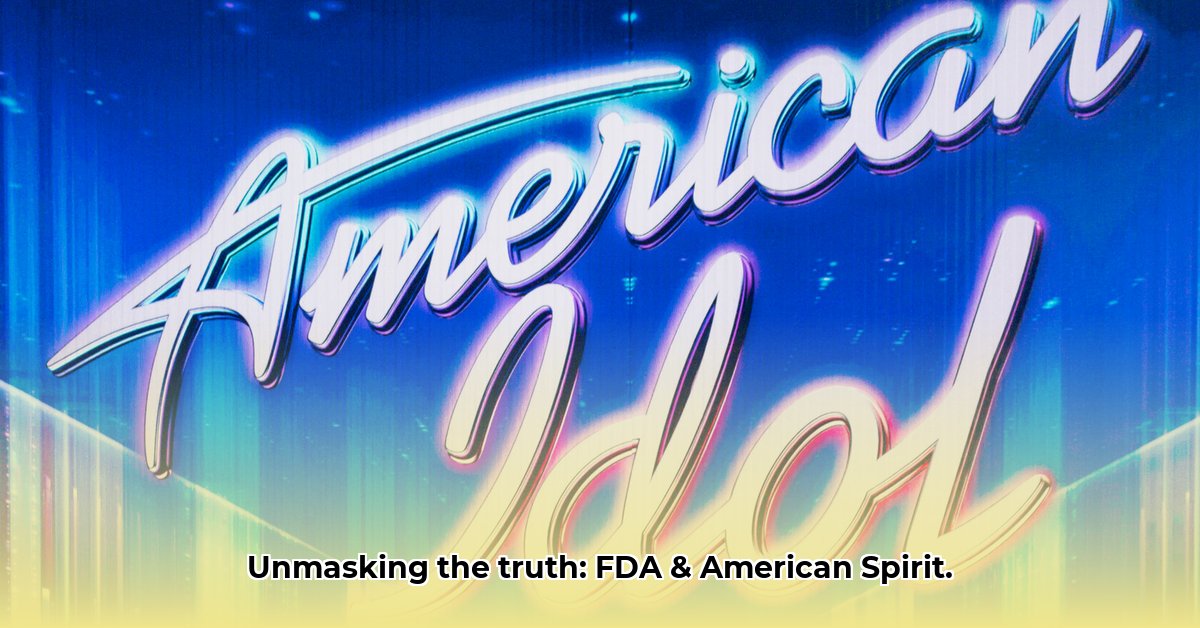Claims that American Spirit cigarettes are “healthier” persist due to marketing. This article examines the facts surrounding American Spirit, FDA regulations, potential health risks, and areas where more research is needed. We will compare marketing claims to scientific evidence, and explore the need for further research to fully inform public health strategies. For more detailed information on health risks, see this helpful resource.
American Spirit FDA Regulation: Unpacking the “Natural” Claims and Misleading Marketing
American Spirit cigarettes are often marketed using terms that imply a healthier option, such as “natural.” But is this accurate, or simply a marketing tactic? This article examines the FDA’s regulatory efforts to combat misinformation surrounding these products and assesses the effectiveness of those measures.
Marketing’s Smoke and Mirrors: Separating Fact from Fiction and Understanding Nicotine Levels
American Spirit’s marketing creates a perception of a safer option. However, scientific evidence presents a complex picture. While some studies suggest lower levels of certain cancer-causing chemicals compared to some other brands, this does not mean they are harmless. American Spirit cigarettes still contain harmful substances. Evidence also suggests that smokers of American Spirit cigarettes may be exposed to higher nicotine levels per cigarette, raising concerns about their addictive potential. The FDA’s attempts to address these misleading claims are crucial for public health.
FDA’s Response: A Work in Progress in Addressing Consumer Perception
The FDA’s efforts to clarify misleading marketing began with a 2017 agreement with the manufacturer, aiming to curb overly positive messaging. Yet, many smokers still believe American Spirit cigarettes are less harmful. This persistent belief highlights a need for clear, consistent messaging about the risks of all cigarettes. The FDA’s actions, while a starting point, may not be sufficient to fully address the problem and require ongoing assessment and refinement.
The Big Unknowns: Research Gaps and Future Directions Regarding Long-Term Health Effects
Significant knowledge gaps remain about the long-term effects of smoking American Spirit cigarettes. Are young people particularly vulnerable to the brand’s marketing tactics? Are current regulations truly effective in preventing misperceptions and protecting public health? More research is needed, including long-term studies and investigations into the impact of marketing on youth. Answers to these questions will inform future FDA regulations and public health strategies.
Who’s Responsible? A Collaborative Approach for Tobacco Control and Public Health
The responsibility for addressing misleading claims about American Spirit cigarettes extends beyond the FDA. The manufacturer should prioritize transparency and avoid misleading language in marketing materials. Public health organizations must intensify their efforts to educate the public about the dangers of all cigarettes. Healthcare providers should be equipped to provide patients with accurate and comprehensive information about the risks of smoking. Effective regulation and public health require a collaborative, multi-faceted approach.
The Regulatory Landscape: A Snapshot of Enforcement Efforts
| Stakeholder Group | Current Role & Challenges | Needed Improvements |
|---|---|---|
| FDA & Regulatory Bodies | Current rules haven’t changed public perception enough. | Stronger regulations, improved enforcement, targeted public health campaigns. |
| Tobacco Companies | Marketing may still be misleading despite regulations. | Transparency, elimination of misleading claims, investment in harm reduction research. |
| Public Health Organizations | Raising awareness campaigns are ongoing. | Expanded campaigns, focus on debunking common misconceptions, youth outreach. |
| Healthcare Providers | Information given to patients isn’t always consistent. | Consistent patient education about all cigarette risks, counseling resources. |
The fight against misinformation about “natural” cigarettes is ongoing. Regulation is essential but requires continuous improvement and broader public health initiatives. Collaboration is crucial to ensure consumers have the necessary information to make informed decisions about their health. The situation is complex and requires further research to understand long-term health effects and the impact of specific marketing strategies. This new data may prompt adjustments to current regulations and marketing restrictions.
How To Debunk American Spirit Cigarette’s “Natural” Marketing Claims
Key Takeaways:
- American Spirit’s “natural” claims are misleading and often lack scientific support.
- The FDA and lawsuits have challenged American Spirit for deceptive marketing practices.
- Understanding FDA regulations on tobacco advertising is critical to debunking these claims effectively.
- Critical consumer awareness is essential; individuals should question and research the accuracy of marketing claims.
The “Natural” Illusion: Marketing vs. Reality Regarding Additive-Free Cigarettes
American Spirit’s marketing often depicts naturally grown, additive-free cigarettes. However, the reality, substantiated by extensive evidence, is different. The FDA has issued warning letters, and numerous lawsuits highlight the deceptive nature of their marketing. These legal actions focus on terms like “natural,” “additive-free,” and “organic,” creating a false sense of reduced health risk.
American Spirit’s sales have increased despite declining smoking rates, underscoring the effectiveness of their misleading claims. A careful comparison of scientific evidence and marketing materials reveals the deception.
FDA Regulations and their Impact on Labeling and Tobacco Advertising
The FDA regulates tobacco advertising to prevent misleading health claims and protect public health. They have acted against American Spirit, highlighting the illegality of certain elements of their marketing. However, the ongoing success of this misleading marketing presents a challenge. More robust regulations and more rigorous enforcement are needed.
The FDA’s standards for “modified risk tobacco products” require robust scientific backing, which American Spirit’s claims lack. This disparity between marketing and science is central to debunking their claims. The company has not provided compelling evidence to support its “natural” assertions.
Uncertainties and the Path Forward for Evidence-Based Decisions
While much is known, uncertainties remain. The long-term health consequences of smoking American Spirit cigarettes, despite their marketing, are not fully understood. The precise impact of this marketing on younger smokers is also unclear. This underscores the need for continued research and increased regulatory oversight. Understanding these uncertainties is critical for developing impactful and effective strategies.
Dissecting the Deception: A Step-by-Step Guide to Educate Consumers
Here’s a simple guide on how to debunk American Spirit cigarette’s “natural” marketing claims:
- Identify misleading terms: Look for terms like “natural,” “additive-free,” “organic,” or similar claims that imply a safer product.
- Examine the scientific evidence: Search for independent studies analyzing the health effects of American Spirit cigarettes and compare them to the company’s claims.
- Recognize marketing tactics: Identify techniques used to create a misleading image, including visuals, language, and associations.
- Analyze FDA actions: Investigate previous FDA actions against American Spirit, such as warning letters or related lawsuits.
- Educate yourself and others: Share your findings to help spread awareness among the public and encourage critical thinking.
This analysis references legal documents and FDA statements about American Spirit’s marketing practices.
American Spirit Marketing Tactics and Their Impact on Youth Perception
American Spirit cigarettes, marketed as “natural,” pose a complex regulatory challenge. Their packaging creates a perception of reduced harm, a “health halo” effect, particularly strong among young adults. But is this image accurate? Does it influence young people’s choices? Let’s delve into the details.
The “Natural” Illusion: Marketing vs. Reality and Adolescent Smoking
American Spirit’s marketing heavily uses imagery suggesting natural, organic ingredients, a central component of American Spirit Marketing Tactics and Their Impact on Youth Perception. However, scientific evidence consistently indicates that all cigarettes, including American Spirit, carry significant health risks. The “natural” label is deceptive, creating a false sense of security, especially dangerous for young people with developing critical thinking skills. Studies show the packaging impacts perceived harm.
FDA Action and Its Effectiveness Regarding Advertising and Marketing Claims
The FDA has taken steps to address American Spirit’s deceptive marketing, and some misleading labels have been removed. But have these actions truly countered the “health halo”? The visual cues and overall aesthetic of the packaging may still drive misperceptions. The FDA needs to address implicit messaging within the packaging design to fully neutralalize the “health halo” effect.
Uncertainties and Gaps in Understanding and Overall Health
While significant research demonstrates the misleading nature of the marketing, questions remain. Further study is needed to know each visual element’s contribution to the misperception. Also, we don’t fully understand the long-term health effects of concerning additions like charcoal filters. This lack of data hinders effective regulatory strategies.
The Urgent Need for Further Research on Long Term Health
The effects of American Spirit Marketing Tactics and Their Impact on Youth Perception are substantial. More research is vital to understand marketing subtleties and develop more effective regulatory responses. Studies focusing on the long-term impact of the “health halo” effect, particularly on vulnerable populations like youth, are crucial. We need precise, data-driven insights to guide future regulatory efforts and protect public health.
Key Takeaways:
- American Spirit’s “natural” marketing creates a misleading perception of reduced harm among consumers.
- This deceptive branding disproportionately affects youth perceptions, influencing their choices and potentially leading to increased rates of smoking initiation.
- FDA regulations have had limited success in neutralizing the “health halo” effect, which remains a powerful influence on consumer perception.
- Further research is needed to fully understand the impact of specific visual cues and long-term health effects associated with American Spirit cigarettes.
- Stronger, comprehensive regulatory measures are essential to protect public health, especially vulnerable youth, from false and misleading advertising.
- Lunch Box That Fits Bento Box Neatly for Daily Use - December 5, 2025
- Japanese Lunch Bag Does Double Duty as Bento Carrier and Tote - December 4, 2025
- Your Perfect Bento Box Bag For Fresh And Tidy Meals - December 2, 2025










